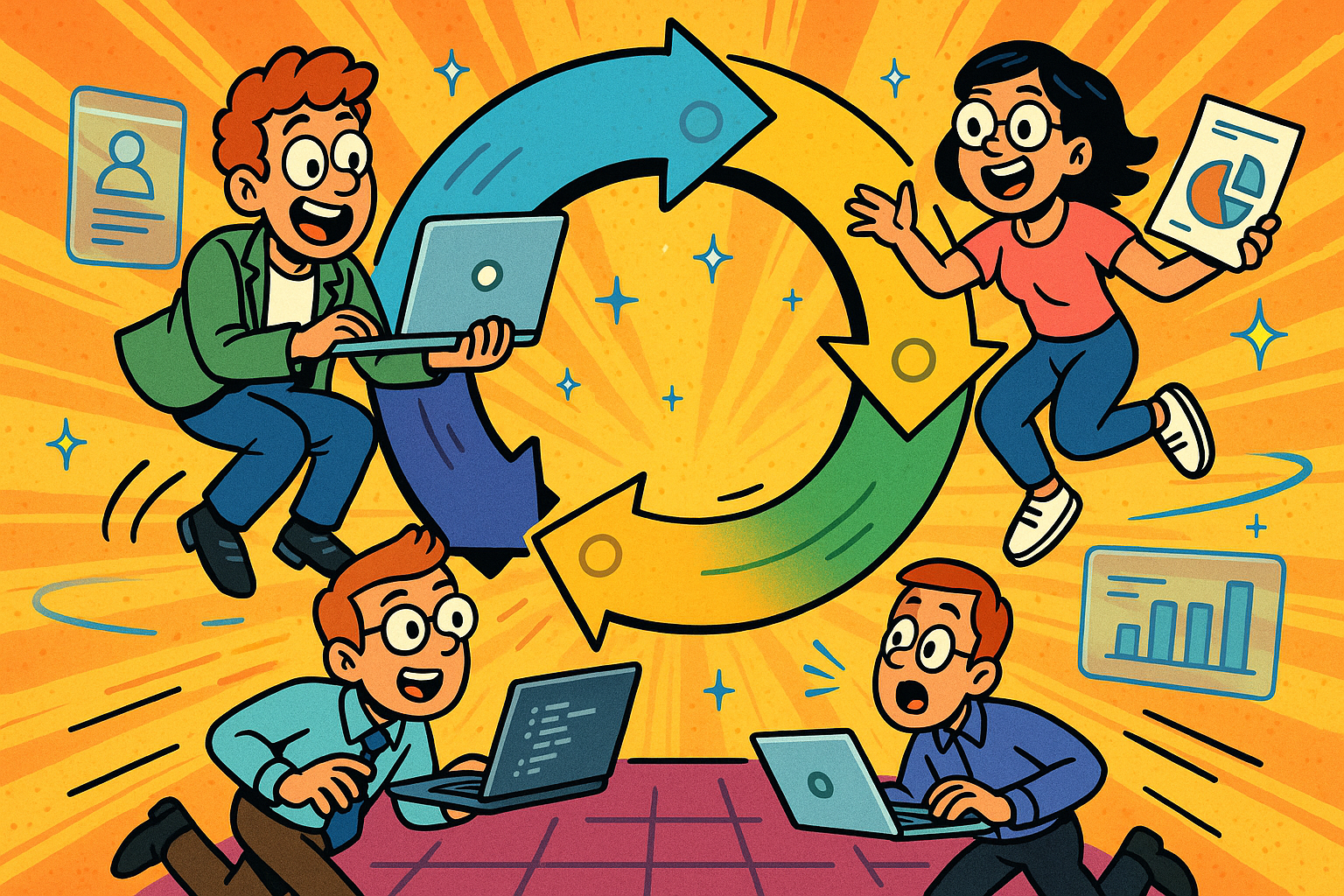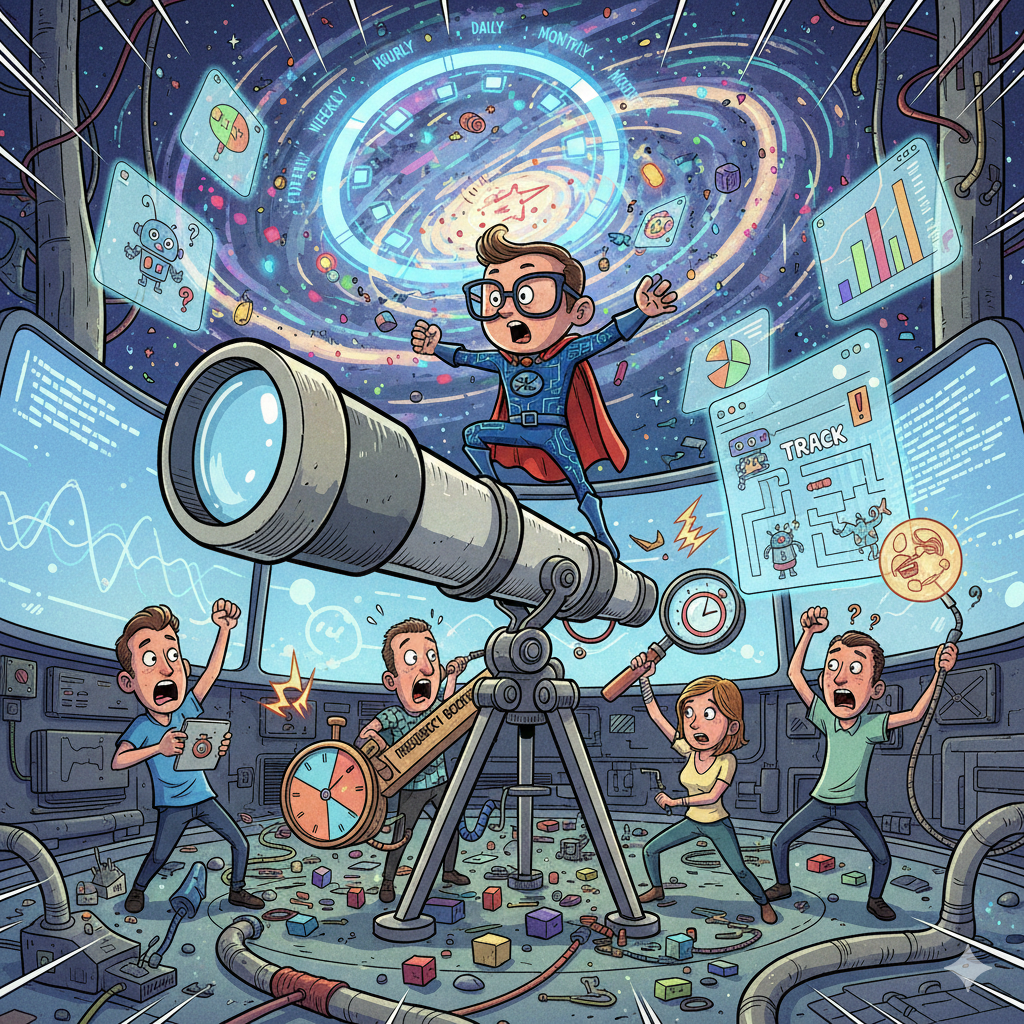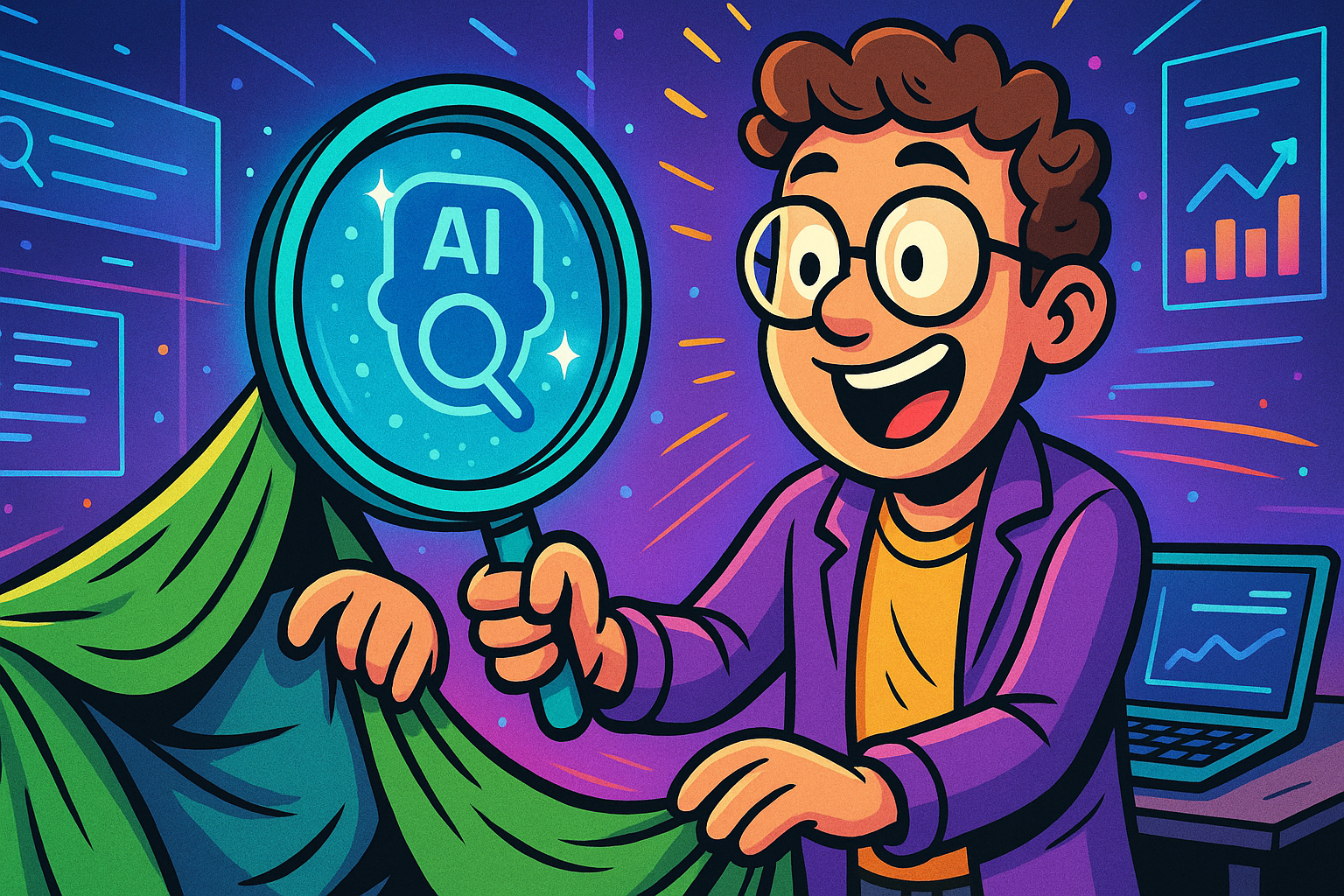A lifecycle content strategy in SaaS is the intentional planning and creation of content that aligns with each stage of the buyer journey i.e., from first touch to purchase and beyond.
Instead of producing isolated blog posts or campaigns, every piece of content is mapped (often by SaaS content strategy experts) to a specific funnel stage:
- Top of Funnel (TOFU)
- Middle of Funnel (MOFU)
- Bottom of Funnel (BOFU)
HubSpot highlights that aligning content across every stage (from awareness through consideration to decision) improves engagement, shortens sales cycles, and improves the conversion of free trials to paying customers.
Real-World Example
A B2B SaaS company offering AI analytics might:
- Use thought‑leadership posts and trend‑driven blogs at the TOFU stage to build awareness.
- Deploy gated industry case studies, comparison guides and webinars at the MOFU stage to nurture interest.
- Offer interactive ROI calculators, free trials and pricing pages at the BOFU stage to drive conversions.
Table of Contents
Why a Lifecycle Approach Matters
Research confirms the power of content across the full funnel. According to the Content Marketing Institute:
- 87% of SaaS marketers say content builds brand awareness (TOFU)
- 74% generate leads (MOFU)
- 62% nurture prospects further
- 52% grow customer loyalty, and
- 49% drive direct sales
Start by defining clear buyer personas and mapping their journey. As WebAscender emphasizes: “create buyer personas first” and use lead scoring to identify when buyers move from stage to stage. Then align each content asset with the right buyer questions (awareness, evaluation or decision).
💡 For custom guidance on applying this framework to your roadmap, book a call with The Rank Masters.
How Does Lifecycle Content Align With the SaaS Buyer Journey?
Lifecycle content aligns with the SaaS buyer journey by matching each piece of content to the exact decision stage a prospect passes through, from first discovery to purchase, so content doesn’t just inform, it propels the buyer forward.
When your editorial calendar is mapped against a B2B SaaS content audit checklist, gaps and overlaps in that journey become visible (and fixable).
Here's how the mapping aligns with SaaS buyer journey:
| Buyer Stage | Lifecycle Content Stage | Content Goal | Example Content |
|---|---|---|---|
| Awareness | TOFU | Attract and educate | Blog post, SEO guide, ebook |
| Consideration | MOFU | Nurture and qualify | Case study, webinar, email series |
| Decision | BOFU | Convert and close | ROI calculator, demo video, pricing page |
Aligning content to each stage of the buyer’s life cycle creates a sense of continuity and builds trust which are two integral ingredients in complex SaaS sales journeys.
Quarterly, many teams run a SaaS content audit & fix sprint, updating outdated TOFU guides, injecting fresh case studies into MOFU workflows, and tightening BOFU calls‑to‑action.
A July 2025 Gartner survey of 632 B2B buyers found that 73% actively avoid suppliers who send irrelevant outreach, proving mis‑aligned content creates friction. Running the steps in how to do a content audit keeps every asset laser‑matched to the buyer’s needs.
Finally, pair lifecycle mapping with dedicated CRO for product‑led content services to turn an aligned journey into on‑page actions that lift free‑trial sign‑ups and demo bookings.
What’s the Difference Between TOFU, MOFU, and BOFU Content?
Understanding the difference between TOFU, MOFU, and BOFU content is key to building a content strategy that moves buyers from discovery to decision.
Each stage serves a distinct purpose,
Here’s how:
1. Top‑of‑Funnel (TOFU) — Awareness
The goal of TOFU content is to attract new audiences and introduce them to a problem or opportunity without pushing a hard sell. At this stage, prospects are just beginning to explore solutions and may not even know your product exists. Your content should educate, spark curiosity and drive engagement.
Working TOFU Formats:
- Blog posts focused on industry trends or pain points
- Educational videos and explainers
- Infographics and data visualizations
- SEO‑optimized guides like our step‑by‑step content audit guide
- Interactive quizzes or social content
- Thought leadership or founder POVs
Best Practices:
- Prioritize value over product. Your brand should be present but not dominant.
- Use emotional resonance and storytelling to make problems feel relatable.
- Target broad but relevant channels like organic search, social media, and partnerships.
- A/B test headlines and hooks to improve click-throughs and reduce bounce rates.
- Align topics with audience pain points (what they’re Googling, not what you’re selling).
Metrics to Watch:
- Pageviews and unique visitors
- Average time on page
- Scroll depth and bounce rate
- CTR to MOFU content
- Email sign-ups or newsletter opt-ins from TOFU landing pages
2. Middle‑of‑Funnel (MOFU) — Consideration
At the MOFU stage, prospects are aware of their problem and are actively comparing solutions. Content here must educate deeply, show credibility, and begin building trust. MOFU content should guide leads toward decision by helping them understand your differentiators without sounding salesy.
Working MOFU Formats:
- Case studies and success stories
- Webinars and on-demand demos
- Product explainers and comparison guides
- Ebooks, templates, or checklists
- In-app tooltips and email nurtures
- Interactive tools like feature tours or assessments
Best Practices:
- Segment content by persona, industry, or use case to increase relevance.
- Use lead scoring and behavior tracking to trigger the right content at the right time.
- Include lightly gated assets to convert anonymous visitors into leads.
- Repurpose content across channels (e.g., turn a webinar into a nurture sequence).
- Partner closely with sales to ensure content addresses common objections, and leverage our SaaS content marketing services for proven frameworks.
Metrics to Watch:
- Content downloads and form fills
- Webinar registration and attendance rates
- Email open/click-through rates in nurture flows
- Lead-to-MQL progression
- Time spent on comparison or feature pages
3. Bottom‑of‑Funnel (BOFU) — Decision & Retention
The BOFU stage is where qualified leads make a final decision. Your content’s job here is to remove friction, build confidence, and guide the prospect toward conversion. It's also where retention content begins nurturing customers post-purchase to reduce churn and drive expansion.
Working BOFU Formats:
- Product demo videos or self-serve trial environments
- ROI calculators and TCO comparison tools
- Detailed case studies with measurable outcomes (see our AI SEO BOFU case study)
- Consult-like sales pages and pricing explainers
- Competitive battlecards and objection-handling pages
- Onboarding emails, user guides, and how-to videos for retention
- Customer-only webinars and upsell prompts for expansion
Best Practices:
- Be as specific and personalized as possible customized content outperforms generic offers.
- Align closely with sales: content should support outreach, not duplicate it.
- Make CTAs low-friction and clear (e.g., “Start Free Trial,” “Book Your Demo”).
- Include proof points: customer quotes, ratings, ROI outcomes, or integrations.
- Don’t stop at conversion! Deliver onboarding and product education to reduce time‑to‑value and churn. For expert assistance, explore our CRO services for SaaS.
Metrics to Watch:
- Trial sign-ups or demo requests
- MQL-to-SQL conversion rate
- Win rates from content-influenced leads
- Customer activation rates post-purchase
- Churn rate, expansion revenue, or NPS (for retention content)
Why is Lifecycle Content Key to SaaS Conversion Growth?
Lifecycle content is one of the most reliable levers for improving SaaS conversion rates because it delivers the right message at the right time to buyers with specific intent signals. When each funnel stage is covered, you:
- Reduce friction by answering buyer questions pre‑emptively
- Build trust through continuity and education
- Hand sales & product‑led paths better‑qualified prospects
But when SaaS teams produce content in silos without aligning to TOFU–MOFU–BOFU intent they often attract unqualified traffic or lose high-intent leads mid-funnel.
Stat Insight: Companies that invest in consistent content marketing generate nearly 6 × higher website‑conversion rates (2.9 % vs 0.5 %) than those that don’t, according to Writtent’s 2025 compilation of peer‑reviewed content‑marketing benchmark studies.
📲 Talk to our CRO team about your funnel
How Do I Map Saas Blog Content to Each Funnel Stage?
To successfully map your SaaS blog content to each funnel stage, follow this five-step process:
1. Inventory Your Existing Blog Posts
Export all published URLs and titles into a spreadsheet. Include columns for traffic, conversions, and last update date.
💡 Our B2B SaaS content audit checklist gives you a ready‑made template.
2. Tag Each Post by Intent (TOFU, MOFU, BOFU)
Use metadata, topic cues, and call-to-action types to determine the post’s purpose.
- TOFU attracts traffic (e.g., “What is X?”)
- MOFU educates and compares (e.g., “Top 5 tools for…”)
- BOFU converts (e.g., “Why we switched from Tool A to Tool B”)
3. Align to Buyer Journey Questions
Match posts to buyer intent using a framework like Intercom’s:
- Problem-aware → Solution-aware → Product-aware
4. Identify Gaps and Duplicates
Balance your funnel; if you uncover major holes, the SaaS content audit & fix sprint can fast‑track repairs.
5. Assign Funnel Stage Labels
Add a lifecycle stage column to your content inventory. This becomes the basis for your strategy refresh and internal linking structure.
✅ Pro Tip: SiriusDecisions found that 60–70 % of B2B marketing content is never used at all, largely because it isn’t mapped to a clear buyer need or funnel stage.
How Can I Build a TOFU–MOFU–BOFU Content Matrix?
The most constructive way to align your SaaS content with buyer intent is by using a TOFU–MOFU–BOFU content matrix, a structured framework that links each stage of the funnel to specific content formats and marketing objectives.
If you’re not sure where to start, our content audit consultant guide walks through the exact data points you’ll need to populate the matrix with existing assets.
Below is the Funnel Fit Matrix™, designed for SaaS teams to diagnose coverage gaps and plan future content:
| Funnel Stage | Buyer Intent | Content Goal | Recommended Formats |
|---|---|---|---|
| TOFU | Awareness & Discovery | Generate traffic, educate | SEO blogs, explainer videos, industry reports |
| MOFU | Consideration & Research | Build trust, qualify interest | Case studies, comparison guides, email sequences |
| BOFU | Decision & Purchase Intent | Drive conversion | Demo requests, pricing pages, ROI calculators |
“The Content Marketing Institute’s 2020 report found that 83 % of enterprise marketers focus on early-stage (top-of-funnel) activities and nearly half of the content they create is TOFU, yet only 49 % say their programs successfully generate sales revenue which evidence that an imbalanced funnel can depress conversions.”
Use the above matrix as a quarterly planning framework:
- Map your existing content to each cell
- Then identify gaps to prioritize in your next cycle.
How Do I Automate Funnel-Stage Content Delivery?
Automating funnel-stage content delivery ensures that your SaaS leads get the right message at the right time without manual segmentation.
Here’s a common setup SaaS teams use:
1. HubSpot Workflows
Tag leads based on form fills, content viewed, or email clicks. Then trigger stage-specific nurture sequences e.g., case study (MOFU) after a blog visit, or demo CTA (BOFU) after webinar attendance.
2. Customer.io or ActiveCampaign
Behavior-based journeys that send content based on what users do inside the product or website e.g., inactive trial users receive a BOFU comparison guide.
3. Segment + Mutiny
Use behavioral data to personalize website content dynamically. For example, returning visitors from a pricing page see BOFU content modules instantly.
For example:
“If a visitor downloads a pricing guide → identify as late-stage (BOFU) → serve a product demo or sales consultation CTA.”
Bonus: A single BOFU blog optimised for high‑intent readers helped Fintel Connect raise demo conversions by 29 % (Mint Studios case study, 2025).
Emerging Best Practices for Lifecycle Content (2025)
As buyer behaviors evolve and content saturation increases, SaaS content strategies must keep pace. The smartest teams today are embracing precision over volume. Below are eight best practices shaping the future of lifecycle content:
1. AI-Augmented Creation, Not Automation
AI now plays a central role in production i,e., helping teams ideate, draft, and repurpose faster. The winning approach? Treat AI as a creative assistant, not an autopilot. Teams also use tools like our AI content audit software to speed up editing, generate captions, and personalize snippets without sacrificing quality.
2. Optimize for Conversational & Voice Search
With discovery moving to ChatGPT, Gemini, and other answer engines, structure content around real questions, concise answers, and intent‑matching language to win zero‑click results.
3. First-Party Data & Ethical Personalization
With third-party cookies disappearing, first-party data collection is integral. Use interactive content (like quizzes, gated webinars, and surveys) to gather insights directly from users. Feed this into CDPs for smarter segmentation and personalization.
According to Gartner, 63% of marketers still struggle to deliver customized experiences, making owned data a major advantage. Ethical handling of email lists and behavioral data, along with privacy-first analytics tools (like Fathom or Plausible), is now best practice.
4. Make Content Interactive
Quizzes, ROI calculators, product selectors, and shoppable videos break through passive scrolling while feeding granular behavioral signals back into lead scoring.
5. Emphasize Human-Centric Storytelling
As AI-generated content becomes widespread, buyers gravitate toward authenticity. Showcasing real people.
Use testimonials, behind-the-scenes content, and narrative-driven case studies to reinforce credibility and differentiate your brand voice.
6. Lead with Video-First Strategies
Video is no longer optional. Short-form formats (Reels, TikToks, Shorts) perform best at the top of the funnel, while webinars, demos, and explainers engage prospects in mid- and bottom-funnel stages.
Transcripts, captions, and SEO-optimized video pages ensure accessibility and discoverability. Teams should build video into their content workflows, not treat it as an afterthought.
7. Build Community Through Co-Creation
Modern content isn’t created in isolation. Forward-thinking SaaS companies are growing communities on platforms like Discord, Slack, and LinkedIn, where users participate in Q&As, AMAs, and shared content creation.
This co-created content not only fills funnel stages organically but also acts as powerful social proof.
8. Prioritize Quality Over Quantity — With Consistency
Publishing frequency still matters, but quality is now the differentiator. Focus on evergreen and pillar content that can be updated over time. Avoid low-effort, AI-generated filler and ensure every asset maps to a funnel purpose.
A steady cadence of high-value content drives engagement, builds trust, and sustains growth over time.
Which Frameworks and Formats Work Best at Each Funnel Stage?
Below are the effective frameworks and content formats to use at each stage of the SaaS buyer journey. These recommendations are customized to match your audience’s intent and move them smoothly from awareness to conversion.
Should I Use Buyer Personas or Job Stories in Content Mapping?
A common question during planning, “buyer personas or job stories”? The truth is you need both. Personas define who you’re speaking to, whereas job stories clarify why they take action.
| Approach | Definition | Best For | SaaS Use Case |
|---|---|---|---|
| Buyer Personas | Semi-fictional representations of user types, with demographics and goals | Planning top-of-funnel and awareness content | HubSpot-style personas for SEO blog targeting |
| Job Stories | Contextual narratives that focus on what a user is trying to accomplish | Middle and bottom-of-funnel product alignment | Intercom uses job stories to write onboarding walkthroughs |
Recommendation:
Use buyer personas to attract the right audience, and job stories to drive conversion. Each framework plays a distinct role in lifecycle content:
- Personas help you understand who you're creating content for (their role, goals, and pain points) → Best for top- and mid-funnel content (awareness and consideration).
- Job stories clarify why someone takes action and what they need next to move forward → Best for bottom-funnel content (decision and conversion).
By combining both, you align messaging with both the person and their intent at each stage of the journey.
Lifecycle Content Strategy Vs Content Calendar: What’s The Difference?
A lifecycle content strategy and a content calendar are not interchangeable i,e,. one is a strategic blueprint, the other is a logistical tool.
Here’s the difference:
| Aspect | Lifecycle Strategy | Content Calendar |
|---|---|---|
| Purpose | Defines what content is needed at each stage of the buyer journey (TOFU, MOFU, BOFU) | Schedules when content gets published and who is responsible |
| Focus | Aligns business goals with buyer intent and content purpose | Focuses on timelines, deadlines, and task ownership |
| Strategic Value | Aligns business goals with buyer intent and content purpose | Does not determine if content aligns with strategic goals |
Pro Tip: Think of it this way, your lifecycle content strategy is the GPS, while your content calendar is the day-by-day itinerary.
SaaS teams that build calendars without a lifecycle strategy often end up publishing for consistency instead of conversion (a common cause of traffic-rich, conversion-poor blogs).
What Content Types Convert Best at TOFU, MOFU, and BOFU?
The highest‑performing format at each funnel stage depends on what the visitor needs next, not what we feel like publishing.
Here’s how to match each content format to its role in moving buyers closer to conversion:
| Funnel Stage | Goal | Best-Performing Content Types | Why It Converts |
|---|---|---|---|
| TOFU | Attract & educate | SEO blog posts, explainer videos, industry reports | Builds awareness, captures problem-aware searchers |
| MOFU | Nurture & qualify | Case studies, comparison guides, interactive webinars like our AI SEO success story | Addresses objections, shows value and social proof |
| BOFU | Convert & close | ROI calculators, product tours, pricing one-pagers, demo CTAs | Reduces friction, validates purchase decision |
Example: Replacing static assets with self‑paced, interactive demo videos can lift MQL‑to‑SQL conversion rates by 36 %, according to Gartner’s latest buyer‑enablement research.
Pro Tip: When planning content, use this structure to make sure stage–format alignment otherwise, you risk educating without converting.
Should Bottom-Of-Funnel Saas Content Be Gated Or Ungated?
Whether to gate bottom-of-funnel (BOFU) SaaS content comes down to a tradeoff between lead qualification and conversion friction. Use the table below to evaluate:
| Approach | Pros | Cons | Best Use Case |
|---|---|---|---|
| Gated BOFU | Captures high-intent leads; feeds Sales with contact data | Adds friction, can reduce engagement | Enterprise SaaS with sales-assist motion |
| Ungated BOFU | Increases consumption; improves user experience | May lose attribution; harder to trigger nurture flows | PLG SaaS or trial-based self-serve models |
Rule of thumb: If your content has buying intent but needs qualification, gate it. If it’s product-proofing or validation, leave it open.
What Are Signs That My Lifecycle Content Is Misaligned And How To Fix Them?
Misaligned content isn’t bad content, it’s the right asset surfacing at the wrong moment. Watch for these red flags. Here are clear signs that your SaaS content isn’t lining up with the funnel:
- High TOFU traffic but low conversion: Your blog brings in visitors, but there’s no pathway to trials or demos.
- Content lacks clear CTAs tied to buyer stage: A MOFU case study ends without a BOFU offer? That’s a dead end.
- Mismatched content sequencing: You send a demo CTA before educating users on the problem. That creates drop-off.
- Underused high-intent assets: BOFU pages like ROI calculators have low traffic because they’re not linked from MOFU pieces.
- One-size-fits-all nurture: Everyone gets the same email sequence regardless of lifecycle stage.
Tip: If your top‑10 traffic pages don’t link to any mid‑ or bottom‑funnel resources, you’re bleeding qualified intent, run a quick content‑funnel health check before the quarter ends.
Why is My SaaS Blog Getting Traffic But No Sign-Ups?
If your SaaS blog is getting solid traffic but no sign-ups, the problem isn’t visibility whether it’s alignment. The most common root causes include:
- Mismatched intent: You're attracting searchers looking for general education (TOFU), but not guiding them toward a product-related next step.
- Weak or absent CTAs: Posts are informative but passive, there's no invitation to act, demo, or learn more about your solution.
- Friction in the funnel: Your MOFU and BOFU content isn’t interlinked, so readers hit a dead end instead of a conversion path.
- Misleading titles or over-optimized SEO: If the post ranks but doesn’t deliver on intent, users bounce before converting.
Benchmarks: When a blog page’s bounce rate rises above 70% and readers spend less than about a minute on the page, the problem is usually a mismatch between the content and the search intent behind the keyword, not poor writing quality.
The Fix
- Segment by stage → group every URL into TOFU, MOFU, BOFU.
- Audit CTAs → ensure they advance the reader one logical step.
- Add mid‑funnel bridges → insert assets like use‑case stories or SaaS case‑study library to guide progression.
These elements help bridge the gap between awareness and decision, moving readers closer to conversion.
How Do I Score And Prioritize Underperforming Funnel Content?
To prioritize underperforming content, use a scoring matrix that evaluates each asset by funnel relevance, performance, and business impact. Here's a simple version of the Funnel Fit Score™:
| Criteria | Weight | Description | Scoring Guide (1–5) |
|---|---|---|---|
| Stage Coverage Fit | 30% | Is the content clearly aligned to TOFU, MOFU, or BOFU? | 1 = unclear or generic, 5 = highly targeted |
| Traffic Volume | 25% | Does it attract meaningful traffic? | 1 = <50/month, 5 = >1,000/month |
| Conversion Influence | 25% | Has it contributed to sign-ups, trials, or demo requests? | 1 = no tracking, 5 = proven BOFU driver |
| Content Freshness & Relevance | 20% | Is it up-to-date, and does it reflect your current messaging/offering? | 1 = >18 months old, 5 = updated quarterly |
✅ Action: Anything scoring > 3.5 and sitting in MOFU/BOFU should jump to the front of your refresh queue. Grab our SaaS content audit checklist to run the numbers and flag easy‑win pages; then book a rapid SaaS content audit sprint if you want a 30‑day turnaround.
Connect the dots: Slot every refreshed page back into your TOFU–MOFU–BOFU content matrix so you see exactly where authority and conversion flow next.
What Causes Drop-Off Between MOFU and BOFU Stages?
Drop-off between the middle-of-funnel (MOFU) and bottom-of-funnel (BOFU) stages is one of the most expensive and most overlooked leaks in the SaaS content journey.
It’s tricky to detect because everything seems to be working: prospects are engaging with content, traffic is healthy, and nurture sequences are firing. But conversions stall.
Here’s why:
1. No Clear Path to Action
MOFU assets like case studies, product comparisons, or webinars often stop short of guiding prospects toward high-intent BOFU actions such as (demo requests, pricing exploration, or ROI calculators). The journey dead-ends instead of accelerating.
2. CTA Misalignment
Even when content is strong, calls-to-action can undercut it. Many MOFU pages still rely on vague, TOFU-style CTAs like “Learn more” or “Contact us.” These lack urgency and clarity, especially for prospects who are already warmed up and seeking something more specific.
3. Content Sequencing Gaps
Often, there’s a jarring leap from educational content to conversion tasks. What’s missing is “bridge content” assets designed to help prospects make confident decisions, such as objection-handling guides, FAQs, competitor comparisons, or detailed implementation walkthroughs.
4. PLG Friction (in Product-led Models)
In product-led growth (PLG) setups, users frequently hit a ceiling in the product without ever reaching BOFU nudges. Why? The content fails to reinforce in-app value moments or anticipate drop-off triggers. As a result, users disengage before they see the full value, or before sales can step in.
According to OpenView’s 2023 SaaS Benchmarks Report, expansion‑stage software companies that revamped their pricing and packaging saw a median 14% increase in net dollar retention (NDR), reflecting faster deal conversion and deeper customer spend.
The Fix: Optimize Your MOFU Experience
- Audit your MOFU (middle-of-funnel) pagesAsk: “Is there a clear, low-friction next step for the prospect?”
- Look for missing or unclear CTAs, such as:
- Start a mini-trial
- View personalized pricing
- Book a low-commitment demo
- Access a product explainer or ROI calculator
Need custom advice? Speak with our SEO strategists about tightening your mid‑funnel flow, and decide whether gated vs. ungated BOFU content is fuelling or blocking conversions.
💡 Pro tip: Don’t just tell users what to do next show them the value of taking that next step.
What KPIs Should I Track for TOFU, MOFU, and BOFU?
The smartest way to keep your funnel healthy is to track stage‑specific KPIs, because success signals look different at each layer.
| Funnel Stage | Key Metrics (KPI) | What It Tells You |
|---|---|---|
| TOFU | Organic traffic, bounce rate, time on page | Are we attracting and holding attention? |
| MOFU | CTA clicks, scroll depth, lead magnet downloads | Are prospects engaging and showing qualification signals? |
| BOFU | Trial starts, demo bookings, pricing page visits | Are buyers converting or requesting more product context? |
Example: A falling BOFU conversion rate is rarely a traffic issue, it’s usually a red flag that last‑mile assets (pricing pages, ROI tools, CTAs) need work. Use AI‑powered content auditing tools to spot and fix gaps fast.
Track KPIs where intent and action intersect, not just vanity traffic.
How Do I Calculate ROI On Lifecycle Content Investments?
A simple formula keeps you honest:
Content ROI = (Attributed Revenue – Content Investment) / Content Investment
- Attributed revenue – sign‑ups, trials, or deals driven by blogs, nurture emails, onboarding guides, or BOFU pages (track via UTMs, GA4, or CRM campaigns).
- Content investment – strategy, copy, design, distribution, and tooling costs over a set period.
Contenly tracked a single B2B deal in which six blog posts and two case studies, classic bottom‑of‑funnel assets cost just $2,650 to produce and directly influenced $41,000 in contract revenue, yielding a 15.5× ROI.
Need sharper numbers? Consider hiring a content audit consultant to validate costs and attribution models, then loop in our SaaS SEO agency when you’re ready to scale what works.
📌 Pro Tip: Track “soft ROI” signals (demo requests, extended time‑on‑page, assisted conversions) when full‑funnel attribution isn’t available, they’re leading indicators of future revenue.
How Do I A/B Test Content Effectiveness Across The Funnel?
To A/B test content effectiveness across the funnel, follow this structured approach:
| Step | What to Do | Why it Matters |
|---|---|---|
| 1 — Choose the funnel stage first | Decide whether you’re testing TOFU engagement, MOFU interest, or BOFU conversion. | A/B tests only pay off when the success metric matches buyer intent. |
| 2 — Define one measurable goal | • TOFU → time‑on‑page or bounce rate • MOFU → CTA clicks or form fills • BOFU → demo sign‑ups or trial starts | A single KPI prevents “noisy” data. |
| 3 — Create two distinct variants | Change one high‑impact element e.g., headline copy, CTA placement, or gated PDF vs interactive calculator. Keep everything else identical. | Isolates the real performance driver. |
| 4 — Pick the right testing tool | Optimizely, VWO, Convert.com, or HubSpot Experiments for built‑in CMS tests. | Ensures clean traffic splits and reliable stats. |
| 5 — Run long enough for signal | Aim for 95 % statistical confidence and 2–4 weeks of consistent traffic. | Avoids false positives that waste dev time. |
| 6 — Scale the winners | Roll out high‑performing BOFU formats, e.g., interactive calculators, across other pages. Use our fast SaaS content fix service to ship changes in days, not months. | Turns micro‑wins into macro impact. |
Avoid vanity victories: TOFU tests need volume before they’re worth running. If you’re just starting, consult our beginner’s audit guide to flag high‑traffic pages first.
What Benchmarks Define Successful Funnel Content Performance?
Below are up‑to‑date SaaS benchmarks (2024‑25 datasets) for each funnel stage, with authoritative sources you can cite in decks or dashboards.
Remember that real‑world performance is contextual, use these numbers as guard‑rails, then fine‑tune targets for your traffic mix, price point, and sales cycle.
1. Top‑of‑Funnel (TOFU) — Awareness
| Metric | “Good” range |
|---|---|
| Organic search CTR | 1 – 3 % (median across SaaS SERPs) |
| Bounce rate | ≤ 65 % (keep below industry high of 70 %) |
| Average time on page | ≥ 82 s (≈ 1 min 22 s) for B2B sites |
| Scroll depth | 70 % of visitors scroll before page fully loads, design CTAs accordingly |
2. Middle‑of‑Funnel (MOFU) — Consideration
| Metric | Benchmark |
|---|---|
| Lead‑magnet (ebook/video) opt‑in rate | 24 % for video‑based magnets (top performers hit 25 %+) |
| Webinar attendance | 40 – 50 % of registrants show up live |
| Email nurture CTR | 3 – 4 % average for B2B SaaS |
| Lead → MQL conversion | 34 – 41 % (small‑/mid‑market SaaS) |
3. Bottom‑of‑Funnel (BOFU) — Decision & Conversion
| Metric | Benchmark |
|---|---|
| Free‑trial / demo conversion (visitor → trial) | 15 – 20 % average opt‑in free‑trial conversion (18.2 % mean) |
| Interactive ROI / TCO calculator completion | 40 – 70 % completion; 25 – 45 % lead‑conversion |
| Demo → Opportunity rate | 30 – 50 % (SQL → Opportunity 38 % median) |
Benchmark Note: Userpilot’s 2024 SaaS benchmarks place the average opt‑in free‑trial conversion at 18.2 %, while Single Grain’s 2025 lead‑to‑sale study shows that only 25–40 % of Sales‑Qualified Leads (SQLs) advance to true opportunities. If your funnel is stalling at 10 % trial‑to‑pipeline progression, shore up activation emails and in‑app nudges before chasing more top‑funnel traffic.
💡 For deeper diagnostics, compare against a comprehensive SaaS audit list or tap a full‑service B2B SaaS SEO Agency to realign KPIs with revenue.
How Does Lifecycle Content Strategy Evolve With ARR Growth Into 2025?
At <$1 M ARR, content is almost always founder‑led. Educational “problem‑first” pieces, like our CEO’s guide to SaaS content, help validate product‑market fit without overselling.
Once you cross the $1‑5 M threshold, lead generation becomes the priority. Mid‑funnel assets (case studies, nurture emails, landing pages) should point to solution pages such as our SaaS content marketing services, giving prospects a clear next step while you collect first‑party data.
Between $5‑15 M ARR growth accelerates, and so must content scale. Program‑driven expansion tactics like programmatic SEO multiply search coverage while freeing writers to focus on high‑leverage decision content.
At $15 M ARR and beyond, you’re optimising pipeline efficiency, not discovery alone. Personalised BOFU assets (industry‑specific ROI calculators, battlecards) should drop visitors onto conversion‑optimised destinations such as our CRO for product‑led content page, where micro‑conversions nudge trials and demos.
Quick ARR‑stage checklist
- <$1 M: Problem education → Blog / founder POV
- $1‑5 M: Lead capture → Service & case‑study pages
- $5‑15 M: Scale coverage → Programmatic SEO hub
- $15 M+: Pipeline efficiency → CRO‑tuned BOFU assets
🤙 Book a 30‑min strategy call to map your next‑phase content roadmap
Lifecycle Content Strategy That Scales: Key Takeaways for 2025
1. Plan with intent, not volume. Map TOFU→MOFU→BOFU formats, set KPIs, and document the plan with a B2B SaaS content audit checklist.
2. Integrate your stack. Connect automation, CDP, CRM, and CMS so behaviour triggers route leads in real time.
3. Prioritise quality & personalisation. Segment nurture emails and dynamic pages; empathy beats length.
4. Leverage AI wisely. Use AI content audit automation for drafts & variants, but keep humans in charge of tone and accuracy.
5. Measure & iterate fast. A/B test CTAs, watch funnel KPIs, and scale wins, partner with seasoned SaaS SEO professionals when growth outpaces team bandwidth.
Frequently Asked Questions
Lifecycle content should be reviewed quarterly and updated at least biannually. Metrics like declining engagement or out-of-date references are strong signals it’s time to refresh. Keeping content aligned with product updates, new use cases, or evolving buyer pain points makes sure ongoing relevance.
In some cases, yes, with customization. For example, a webinar replay could serve MOFU audiences when paired with a downloadable worksheet and serve BOFU when combined with a case study and CTA. Just ensure messaging and context match the buyer's stage.
Customer success teams often surface the best insights for retention and expansion content. FAQs, onboarding guides, and "how-to" videos created from real support interactions can reduce churn and enable upsell opportunities extending the funnel beyond conversion.
Yes. PLG (Product-Led Growth) models rely more on in-app content, onboarding flows, and trial optimization, while sales-led models lean on gated assets, consultative content, and objection-handling. Hybrid models require both self-serve and sales-assist content working together.
Vary content formats (videos, carousels, interactive tools), segment by behavior or persona, and time delivery thoughtfully. Staggered storytelling, progressive education, and light personalization help keep content feeling fresh, even over extended buying cycles.
Lifecycle Content Isn’t a Tactic — It’s a Revenue Engine
Lifecycle content isn’t just about filling a calendar; it’s about sending buyers the exact message they need at each stage so they glide from discovery to decision.
When your Funnel Fit Framework™ and AI‑assisted ops are backed by a trusted B2B SaaS SEO Agency, every asset, from TOFU blog posts to BOFU demo flows, works in concert to:
- Eliminate friction and shorten sales cycles
- Compound authority with a scalable Mass‑page SEO program
Improve deal velocity by earning Quality links for SaaS that raise the floor for every keyword you target.
👉 Ready to turn content into a predictable pipeline? Speak with our SEO strategists and see how quickly intent can become revenue.





